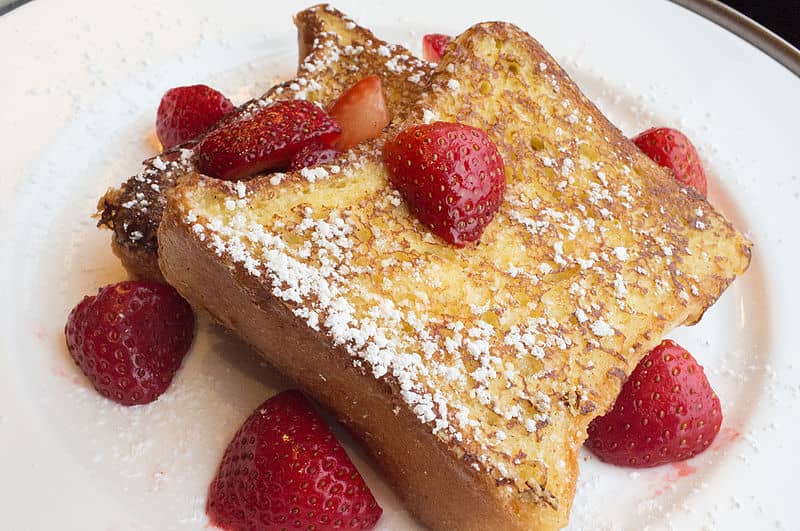Are you wondering what’s the history and the origin of French toast?
Perhaps like most people, you think French toast was invented in France. Oh, just another of those typical French “fabulosities,” nothing surprising. Right?
But is it really French, though? Is it called French toast everywhere? How do you make this breakfast comfort food?
Things you'll find in this article
French Toast – History And Origin

Let’s delve deeper into this simple yet intriguing dish made of old bread to answer these questions – and more.
The Bread with many names
The French call it “pain perdu” – the “lost bread”. It’s a real simple recipe that typically requires only about 4 basic ingredients: milk and eggs, butter, and stale bread.
French toast has many other names – “eggy bread”, “omelette bread”, “Bombay toast”, and “poor knights of Windsor”, “Spanish toast”, “German toast”, “nun’s toast”, and “French-fried bread”.
There are more variations but these are the most common.
History and Origin of French Toast
It is believed that French toast was invented by impoverished European cooks in the Middle Ages, who, in order to feed their families, had to use every bit of food they could find.
They moistened and heated day-old bread, then added eggs for extra moisture. They fried it to a toast… and thus the French toasts were born.
The earliest known reference to French toast is in a collection of Latin recipes called Apicius which means “gourmand”. This collection dates to the Roman Empire, back in the 1st century CE.
Fast-forward to the 14th century when a similar recipe appeared in Germany. There the said recipe was called “Arme Ritter” – meaning “poor knight.”
This name also came to be used in English as well as the Nordic languages.
Still, in the 14th century, an important figure in the early history of French cuisine named Guillaume Tirel, more popularly known as Taillevent, presented an identical recipe which he called “tostées dorées.”
And then in the 15th century, an Italian culinary expert by the name of Martino da Como offered the very same recipe.
In France, the dish was given the name “pain perdu,” a French phrase that means “lost bread”. It was named after the stale bread that if not revived into this dish would otherwise be “lost” or thrown away.
To this day, pain perdu remains a popular comfort food. In fact, French toast became so popular that it has come to be synonymous with France.
Why is it called French Toast?

French Toast with strawberries
In the 17th century, early settlers from England brought the recipe to America. The name “French toast” finally saw the light of day the following century.
It happened in 1724, when an American innkeeper in Albany, New York, by the name of Joseph French replicated the dish and named it “French’s Toast”.
However, not caring too much about grammar, he inadvertently left off the apostrophe, and the name “French toast” stuck.
How French Toast is made and eaten?
French toast is pretty easy to make.
In the Apicius, where it is simply described as aliter dulcia (English: “another sweet dish”), the recipe says to remove the crust of fine white bread before slicing it into large pieces and soaking these pieces in milk and beaten eggs.
These soaked pieces of bread are fried in oil and then covered with honey before serving. This is the earliest version of French toast.
It hasn’t changed much since the Middle Ages. It’s still basically made with eggs, milk, and stale bread. Cinnamon and vanilla extract are sometimes added to the milk and egg batter.
In some recipes, a pinch of salt is also included.
The modern French toast is usually served with side dishes.
Here are some suggested sides to get your day off to a savoury start: sausage, bacon, smoked salmon, scrambled eggs, fresh fruit like berries and peaches, honey, syrup, powdered sugar, and peanut butter. The possibilities are endless!
In England, French toast is sometimes eaten with ketchup.
The Scottish people eat it traditionally as a sandwich – served with sausage between two French toasts.
French toast in France itself is a dessert rather than breakfast, that’s why it’s super sweet compared to those made in other countries.
Italians load the French toast with mozzarella cheese. They call it “mozzarella in carrozza,” meaning “mozzarella in a carriage.”
The best choices of bread to use for French toast are the French brioche and baguette as well as the Jewish challah.
For calorie-watchers, don’t fret. It’s easy to make low-fat, high-protein, high-fiber French toast with a few ingredient substitutions.
Replace milk with unsweetened almond milk or other non-fat milk. Instead of oil or butter, spray your skillet with non-stick spray and cook on medium heat for about 3 minutes on each side.
This breakfast dish is best served with coffee or orange juice.
A Few More Interesting Facts About French Toast

The tastiest French toast I ever had in Cameron, Malaysia
I love interesting facts about food and French toast is not an exemption.
- Ancient Romans called this breakfast delight “pan dulcis.”
- It has not always been called“pain perdu” in France. One of the original French names for French toast is “le pain á la Romaine,” which translates to “Roman bread,” thanks to the French toast’s Roman origin.
- Yet another French name for French toast is “amerite.”
- The first appearance in print of the phrase “French toast” was in 1871, in the Encyclopedia of American Food and Drink.
- French toast is healthy. It’s high in protein, fiber, sodium, selenium, and riboflavin. It is rich in other vitamins and minerals as well.
- The staler bread, the better in making French toast because it better absorbs the batter.
- French toast in France is a dessert rather than breakfast, that’s why they have it much sweeter than those made in other countries.
- Rabanada, the Portuguese version of this dish, is served as a Christmas dessert in Portugal and Brazil.
- In Spain, French toast is served as an Easter dessert called torrijas. And the Spanish sometimes use wine in lieu of milk, then dip it in egg before frying.
- Each year on the 28th of November, Americans celebrate National French Toast Day. There is no detail available on its origin, but thanks to whoever thought of it – we are looking forward to celebrating it!
A Quick And Easy French Toast Recipe
This quick and easy recipe only takes about 10 minutes to prepare and 5 minutes to cook and yields a single serving.
Ingredients:
¼ cup milk
1 egg
2 thick slices of stale bread
1 tablespoon butter
⅛ teaspoon vanilla extract
1 pinch salt
1 pinch ground cinnamon
2 tablespoons honey
Instructions:
1. Mix all the ingredients, except the bread and honey, in a dish or a blender.
2. Whisk well.
3. Soak the bread slices into the mixture for at least 5 to 10 minutes.
4. Cook bread on the griddle on medium heat for a few minutes on each side.
5. Serve warm with honey.

Hi, I’m Christine – a full-time traveler and career woman. Although I’m from the Philippines, my location independent career took me to over 40 countries and lived in 4 continents in the last 10 years, including France. A self-proclaimed Francophile, I love everything France.
